Is it a ball? Is it a Pokémon? Nope, it’s a sea urchin!
Sea urchins, even though common, are really cool! In Morro Bay, there are mainly two species, purple sea urchin and red sea urchin. The biggest difference between the two is their size and color. Red sea urchins can reach up to five inches in diameter whereas purple sea urchins reach only two inches in diameter. The most common species is the pacific purple sea urchin, also known as Strongylocentrotus purpuratus.
Sea urchins use their spikes and poison as a defense mechanism. The poison is located at the base of their spines in their pedicellariae, which are tiny jaw-like structures that can clasp onto a victim and inject a painful poison. Don’t worry—you are more likely to die from an infection from the open wound than from the poison itself. With proper medical care, you should recover quickly.
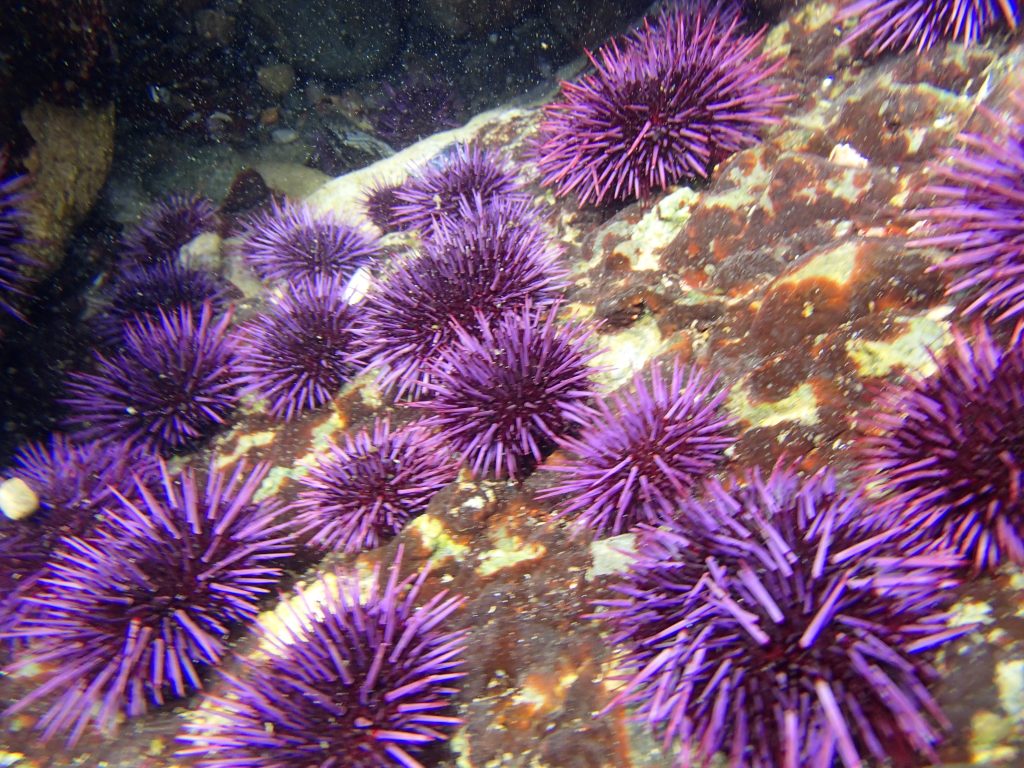
Photo Credit: James Maughn through Flickr via Creative Commons License
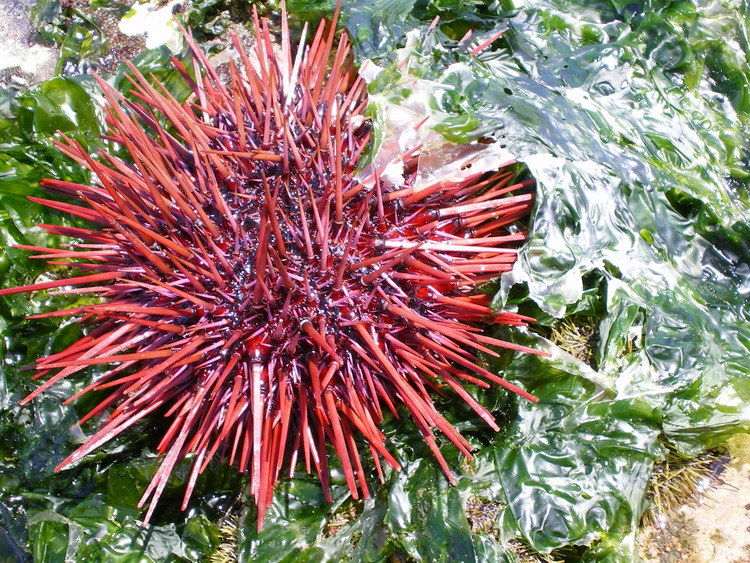
What do sea urchins eat?
They both eat kelp, algae, and decomposed creatures. Mmmmm, tasty!
Can’t see the video shown above? Click here!
How to spot them
You can find red and purple sea urchins from Alaska to Baja California. They often attach themselves to hard surfaces like pilings or jetties. They reside in shallow waters to waters as deep as 100 meters. The easiest way to spot them, if you are not a certified scuba diver, is to go to the tide pools during a negative tide. Field trip time! Want to know when it’s a negative tide? Check this page out! Don’t know where to find tide pools in SLO county? Check this website out!
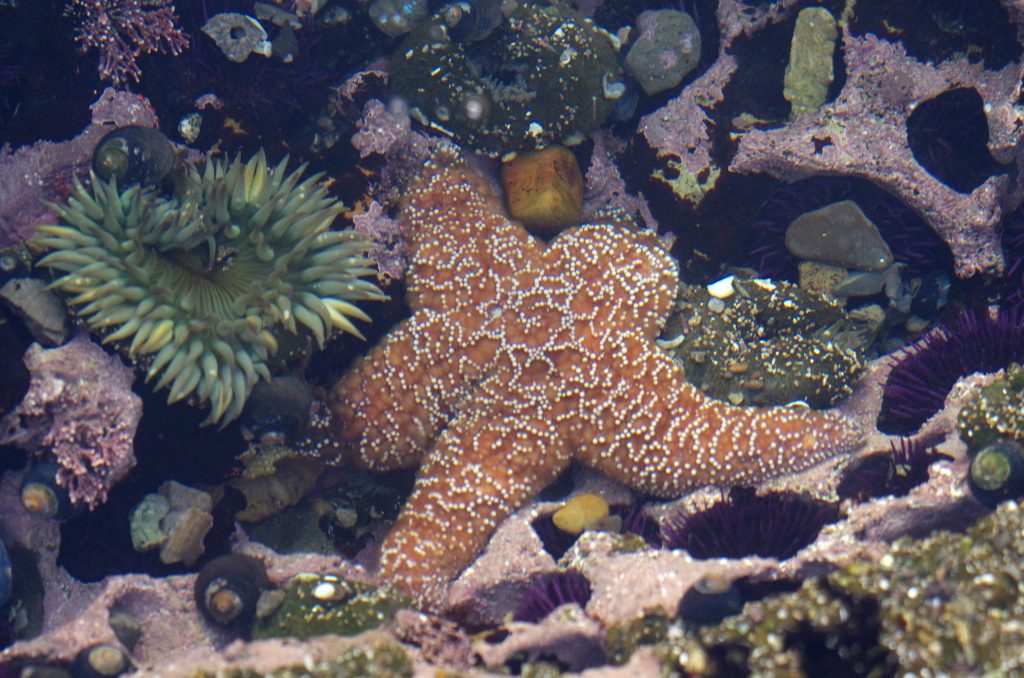
Photo Credit: sarowen through Flickr via Creative Commons License
The problem of sea urchins and kelp forests
Diminishing kelp forests are a huge concern, considering the many different species that depend on these underwater habitats for food and or shelter. Sea urchins depend on kelp as an important source of food. When the kelp forests are large enough to support the number of sea urchins, this isn’t a problem. The issue today is that these two are out of balance; there are too many sea urchins for the dwindling kelp forests to support, which means that the kelp forests just keep getting smaller.
Even though both red and purple sea urchins eat kelp, the main culprit in the current kelp consumption situation is the purple sea urchin. The purple sea urchin is more resilient than the red sea urchin, making it easier for them to out compete red sea urchins for this scarce food source. This, along with the fact that red sea urchins are harvested more often for food, has really decreased the amount of red sea urchin found in the wild.
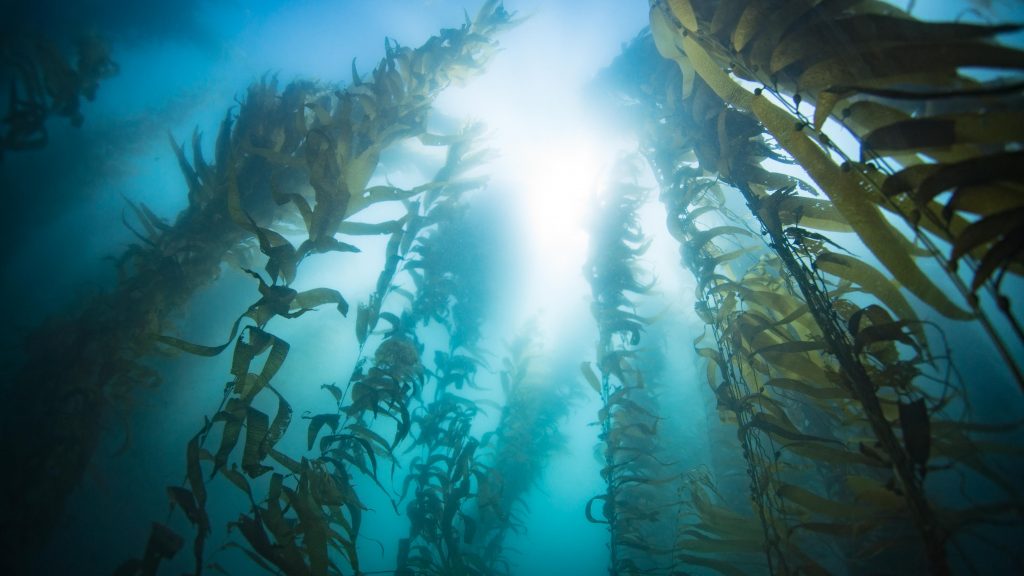
Why are purple sea urchins taking over? To put it simply, rising water temperatures in the ocean appear to be the main factor. These warmer conditions make lengthen the spawning season for purple sea urchins, since they tend to mate during the summer season when the water is warmer. This gives the species the opportunity to produce a lot more offspring.
Sea star wasting disease
Adding fuel to the fire, sea star wasting disease, also known as sea star wasting syndrome, came and killed between 50% and 95% percent of sea stars in affected areas along the Pacific coast, beginning in 2013. This disease is not new; it has appeared sporadically in the past and killed smaller numbers of sea stars. Scientists think that the rising temperature of ocean water and the resulting ocean acidification may have spurred this unprecedented surge of diseased and dying sea stars. These two factors add stress to sea stars, making them more susceptible to the syndrome.
Sea stars are not the only predator of urchins, but they do consume a lot of them. So, when the wasting syndrome caused this massive die off, it greatly reduced the number of sea urchins being eaten, leaving more of them to reproduce, compounding the imbalance of species in the kelp forest.
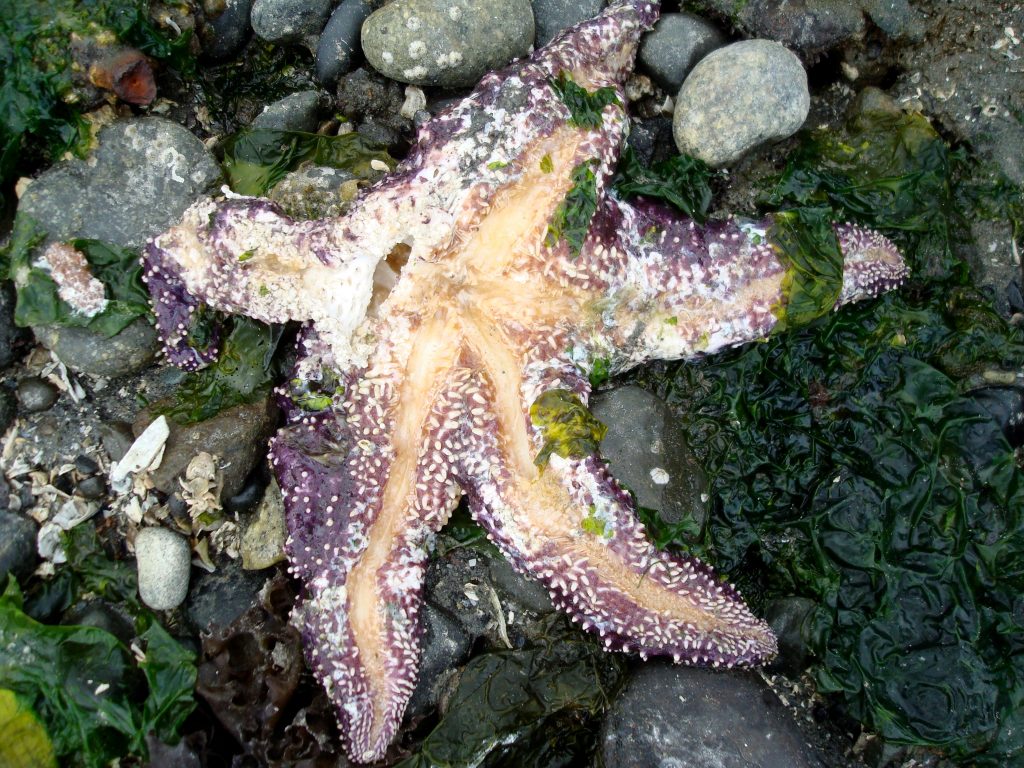
Photo Credit: alisonleighlily through Flickr via Creative Commons License
UC Merced sea star wasting disease video
Can’t see the video above? Click here!
Are kelp forests done for?
There is still hope for kelp forests. They benefit from an unlikely hero, a fluffy one that swooshes through the water and dives down into the depths of the salty sea in search of food. This hero is the California sea otter. These mammals have a generalist diet, meaning that they eat a wide variety of foods. They learn what to eat from their moms when they are pups.
At one point, sea urchins were actually hard to find along the California coast. This caused a cultural memory loss, meaning that sea otter moms could not teach their new pups how to eat sea urchins since there were so few of them. Fast forward to today, and there are a lot of sea urchins, but it takes a while for the sea otters to learn how to eat them and to pass that knowledge along. Thankfully, sea otters are fast learners and they are already munching away.
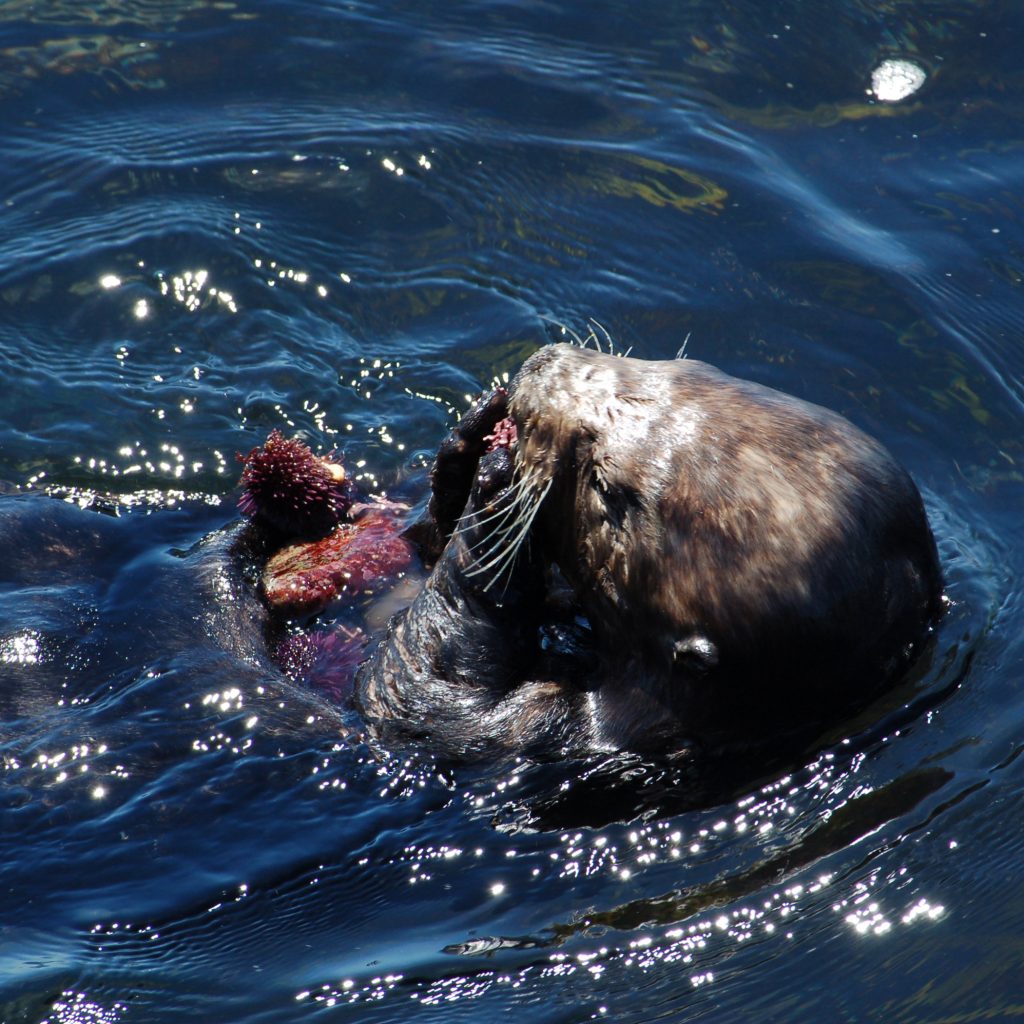
Photo Credit: matt “smooth” thooth knoth through Flickr via Creative Commons License
Sea urchin fisheries
Otters are not the only ones eating more purple sea urchins than they used to, humans are too! Historically, red sea urchins were more often harvested for eating than purple sea urchins because they have much more meat. Now, people are harvesting purple sea urchins, too. A lot of the sea urchins harvested here in California are sent to Japan and used for sushi. Some sushi restaurants on the Central Coast serve it, too, but you won’t see “sea urchin” on the menu; you’ll see it listed as uni.
When sea urchins are harvested to eat, and processed we see another problem with overpopulation, which is that a lot of the sea urchins are starving. We know this because some of the harvested sea urchins have almost no flesh inside. This is due to the lack of food available to the ever-growing population of purple sea urchins, and the diminishing food source in the form of kelp.
Though this is an unfortunate thing for the sea urchins, it will likely reduce their population, putting their numbers back in balance with the resources that they need. This will be good for kelp forests and other species. Once the sea urchin population declines, there will be healthier sea urchins and— hopefully—less kelp forests being devoured.
If you want to learn how uni is harvested? Check this video out!
Urchin fun facts!
- Scientists have found red sea urchins that are 200 years old! That’s just the oldest specimens we’ve found—they may live even longer.
- Sea urchins never stop growing. They just grow very slowly, about a hundredth of an inch per year after they reach adulthood.
- Sea urchins are really sensitive beings, sensitive to pollution that is. They are great water quality indicators because they can’t thrive in areas with significant water pollution. If you’re looking in the water and you can’t find any sea urchins on pilings and other areas where you would expect to find them, that’s not a good sign.
- Juvenile sea urchins use adults for protection and possibly as a source for food. They hide underneath adults until they reach about four centimeters in diameter. From then on, they fend for themselves.
- Did you know that sea urchins can move? Sea urchins tend to be stationary when food is abundant and mobile when food is scarce.
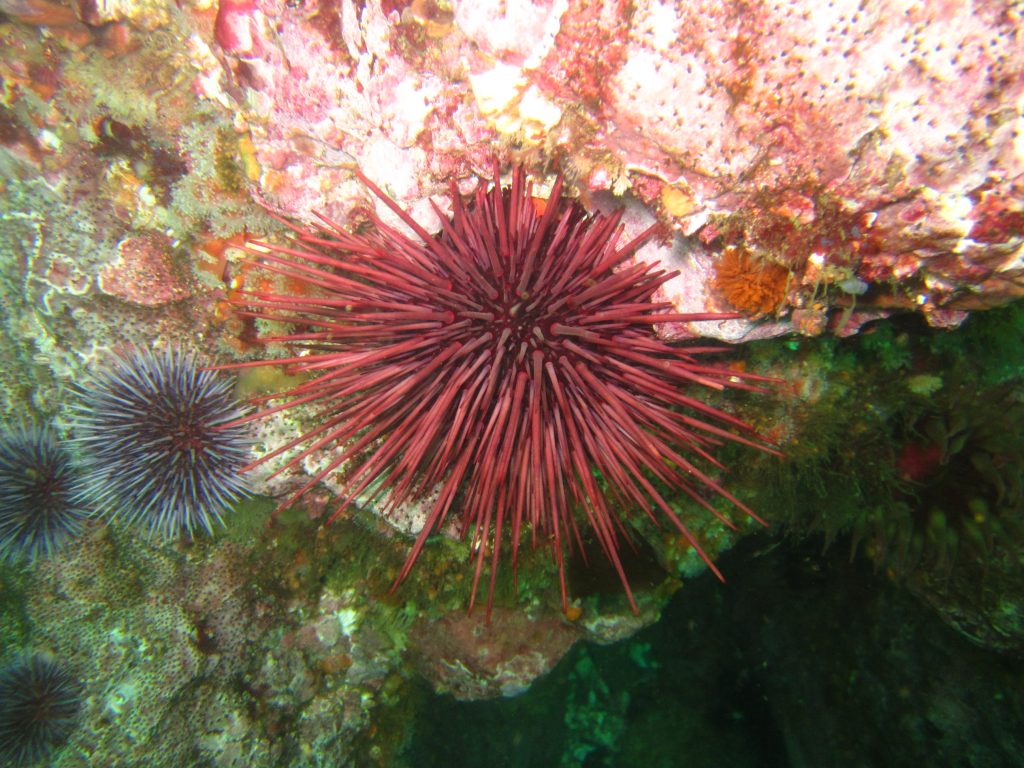
Photo Credit: vagabondvince310 through Flickr via Creative Commons License
Work Cited
Bartholomew, Emily, and Elena Hursky. “Strongylocentrotus Franciscanus.” Animal Diversity Web. Accessed January 7, 2020. https://animaldiversity.org/accounts/Strongylocentrotus_franciscanus/.
Everyday California. “The Unlikely Battle Between Sea Urchins And Kelp.” Everyday California. Accessed January 7, 2020. https://www.everydaycalifornia.com/blogs/everyday-thoughts/the-unlikely-battle-between-sea-urchins-and-kelp.
Heidt, Amanda. “A Sea Urchin Army Is Mowing Down California’s Kelp Forests — But Why?” KQED, July 23, 2018. https://www.kqed.org/science/1927312/a-sea-urchin-army-is-mowing-down-californias-kelp-forests-but-why.
Imbler, Sabrina. “A Minefield of Purple Urchins Devastated Kelp Forests in California.” Atlas Obscura. Atlas Obscura, November 14, 2019. https://www.atlasobscura.com/articles/urchins-devastate-bull-kelp-forest-california.
Kato, Susun, and Stephen Scheoerer. “Biology of the Red Sea Urchin, Strongylocentrotus Franciscanus, and Its Fishery in California.” https://swfsc.noaa.gov/publications/CR/1985/8550.PDF. NOAA, 1985.
“Kelp Forest.” Oceana. Accessed January 7, 2020. https://oceana.org/marine-life/marine-science-and-ecosystems/kelp-forest.
Leonard, George, Elizabeth Cerny-Chipman, Erin Spencer, Henry Huntington, and Sarah Cooley. “Sea Star Wasting Disease: The Catastrophe Beneath the Waves.” Ocean Conservancy, February 5, 2019. https://oceanconservancy.org/blog/2019/02/06/sea-star-wasting-disease-catastrophe-beneath-waves/.
Mahoney, Erika. “Saving California’s Kelp Forest May Depend On Eating Purple Sea Urchins.” NPR. NPR, September 9, 2019. https://www.npr.org/sections/thesalt/2019/09/09/756929657/saving-californias-kelp-forest-may-depend-on-eating-purple-sea-urchins.
Pacific, Aquarium of the. “Red Sea Urchin.” Online Learning Center | Red Sea Urchin. Accessed January 7, 2020. http://www.aquariumofpacific.org/onlinelearningcenter/species/red_sea_urchin.
“Purple Sea Urchin.” Monterey Bay Aquarium. Accessed January 7, 2020. https://www.montereybayaquarium.org/animal-guide/invertebrates/purple-sea-urchin.
“Sea Urchin Facts.” Math. Accessed January 7, 2020. http://www.softschools.com/facts/animals/sea_urchin_facts/479/.
“Diet & Eating Habits.” SeaWorld Parks & Entertainment. Accessed January 10, 2020. https://seaworld.org/animals/all-about/otters/diet/.
Sharman, Jon. “Mass Starfish Death the Biggest Disease Epidemic Ever Seen in Marine Animals, Scientists Say.” The Independent. Independent Digital News and Media, January 31, 2019. https://www.independent.co.uk/environment/starfish-deaths-sea-star-wasting-disease-us-pacific-coast-sunflower-warming-a8756716.html.
Help protect and restore the Morro Bay estuary
- Donate to the Estuary Program today and support our work in the field, the lab, and beyond.
The Estuary Program is a 501(c)3 nonprofit. We depend on funding from grants and generous donors to continue our work. - Support us by purchasing estuary-themed gear from ESTERO. This locally owned and operated company donates 20% of proceeds from its Estuary clothing line and 100% of Estuary decal proceeds to the Estuary Program. Thank you, ESTERO!
- Purchase items from the the Estuary Program’s store on Zazzle. Zazzle prints and ships your items, and the Estuary Program receives 10% of the proceeds. Choose from mugs, hats, t-shirts, and even fanny packs (they’re back!) with our fun Estuary Octopus design, our classic Estuary Program logo, or our Mutts for the Bay logo.
Thank you for your support!